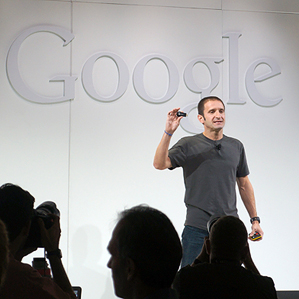Google Launches a Dongle to Bring Online Video to TV
Google launched a two-inch-long device costing $35 at an event in San Francisco today. The device is meant to bring the 200 billion videos watched online each month to regular TV sets. Called the Chromecast, the device resembles a regular USB thumb drive, but plugs into a television’s HDMI port and connects to a home Wi-Fi connection.


Once a Chromecast device has been installed and connected, it is possible to control it using Google’s YouTube app or an online player on an Android or Apple smartphone or tablet, or with a laptop, as long as that device is on the same Wi-Fi network. The Chromecast device then fetches video content from the Internet itself. Through the Chromecast it is possible to turn on a TV, change the volume, pause, skip, and play content.
Other content providers have jumped on board with the effort. Netflix has already integrated the functionality into its Android app, and the music-streaming service Pandora will soon also work with the Chromecast. The device went on sale today in the U.S. and is available from Amazon, Best Buy, and through Google’s Play store.
“Everyone loves their phone, tablets, laptops. Why not make them just work with your TV?” asked Mario Queiroz, the Google vice president who announced the Chromecast on stage. “Your personal device should be your remote.”
Queiroz stressed that any device—whether or not it was made by Google or is running the company’s software—can work with a Chromecast. “We will not force you to have the same operating system on all your devices.” He demonstrated how the YouTube app for iPhone could be used to send content to a TV with a Chromecast plugged in, and said any laptop using a Web video player with Chromecast enabled would be able to use the device.
Queiroz said more content announcements are on the way. “Our goal is to partner to create an ecosystem of apps as well as devices,” he said, claiming that developers of mobile and Web apps would need to make only minor changes to their existing apps to make them compatible.
Queiroz also hinted that the technology inside the Chromecast might soon appear inside other products. Adding the technology to television sets might make sense for both Google and TV manufacturers. “This is the first instantiation of Googlecast; over time we expect the functionality to be embedded in a range of devices,” said Queiroz.
The head of Google’s Chrome and Android projects, Sundar Pichai, said today that only 15 percent of U.S. households currently watch any online video on their TV sets.
No one from Google mentioned it today, but the Chromecast is Google’s second attempt at launching hardware to get more people watching online content on TVs, which are more usually served by broadcast and cable networks. In late 2010, Google worked with electronics manufacturers to launch set-top boxes branded as “Google TV” devices that could play YouTube and other Web content on TVs. However, the devices received poor reviews and sold only in limited numbers.
Keep Reading
Most Popular
Large language models can do jaw-dropping things. But nobody knows exactly why.
And that's a problem. Figuring it out is one of the biggest scientific puzzles of our time and a crucial step towards controlling more powerful future models.
The problem with plug-in hybrids? Their drivers.
Plug-in hybrids are often sold as a transition to EVs, but new data from Europe shows we’re still underestimating the emissions they produce.
Google DeepMind’s new generative model makes Super Mario–like games from scratch
Genie learns how to control games by watching hours and hours of video. It could help train next-gen robots too.
How scientists traced a mysterious covid case back to six toilets
When wastewater surveillance turns into a hunt for a single infected individual, the ethics get tricky.
Stay connected
Get the latest updates from
MIT Technology Review
Discover special offers, top stories, upcoming events, and more.